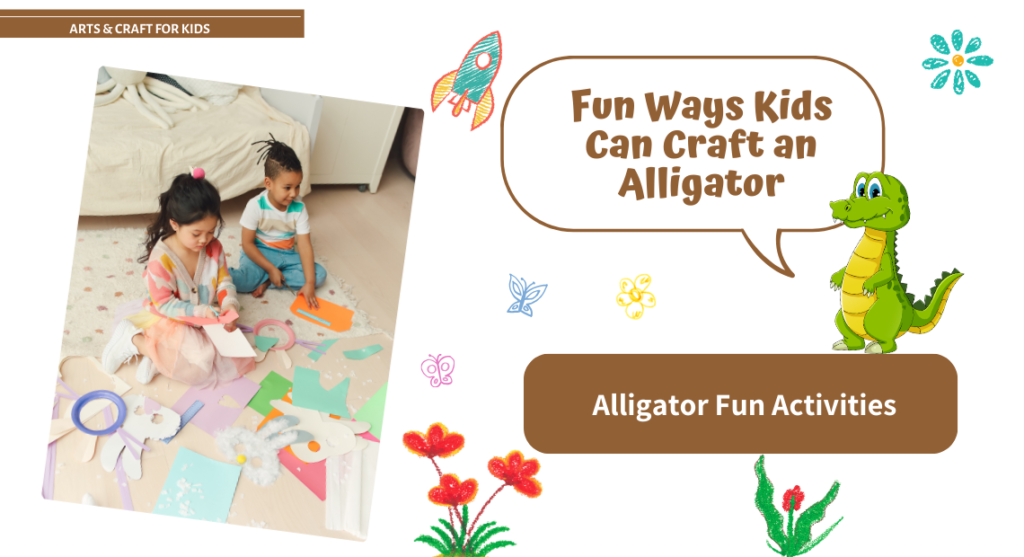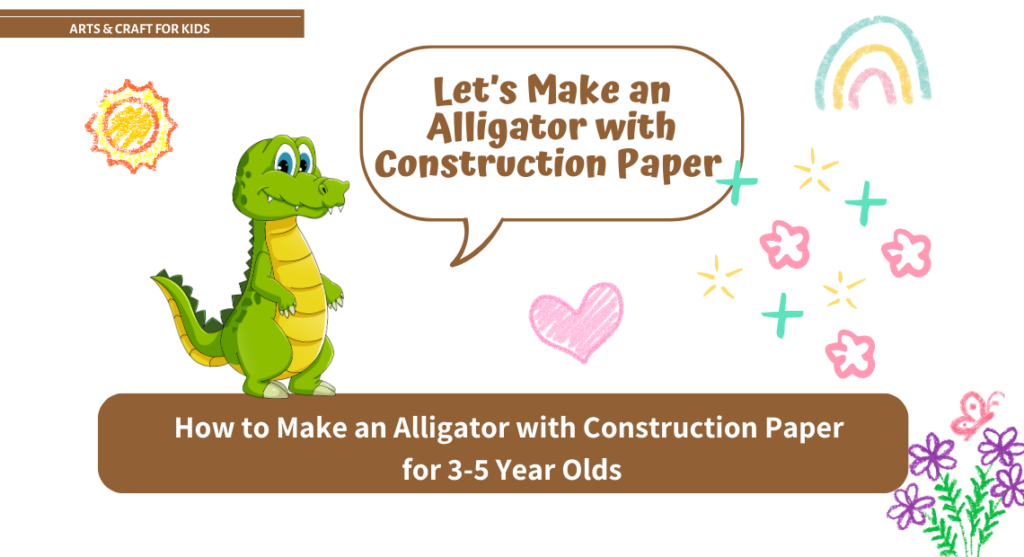Creating an alligator craft with kids is a fantastic way to combine creativity with a bit of animal education. Alligators are fascinating creatures, and making them out of construction paper offers a hands-on learning experience. Below are several creative ways that kids can craft an alligator, each one providing a unique twist on this fun animal project.
1. Handprint Alligator
How-To:
- Use your child’s handprint to create the body of the alligator.
- Have them paint their hand with green paint and press it onto a piece of paper.
- The palm of the hand will become the alligator’s body, and the fingers will be its legs.
- Once dry, cut out the handprint and add details like a head, tail, and eyes.
Why It’s Fun:
- The handprint gives the alligator a unique shape, and it’s a great keepsake craft.
- Kids can even trace their hands multiple times to make a family of alligators!
2. Alligator Paper Roll Puppet
How-To:
- Start with an empty toilet paper roll.
- Paint it green and add a large triangular mouth at one end to form the alligator’s head.
- Use green construction paper to create the body and tail, then glue on googly eyes.
- The paper roll acts as a great handle for kids to make the alligator move and open its mouth.
Why It’s Fun:
- This is a great interactive craft!
- Kids can use their alligator puppet to play out stories or pretend to “chomp” at things around them.
3. 3D Alligator with Craft Sticks
How-To:
- Glue five craft sticks together side by side to form the alligator’s body.
- Paint the sticks green, and then cut out the head, tail, and legs from construction paper or foam sheets.
- Attach the pieces to the craft stick body.
- Add googly eyes and teeth to the head for extra fun.
Why It’s Fun:
- The 3D craft sticks give the alligator structure, and kids can move and arrange the sticks to make it stand up or lie flat.
4. Salt Dough Alligator
How-To:
- Create a salt dough using flour, salt, and water.
- Mold the dough into the shape of an alligator with a long body, tail, and legs.
- Once the dough is dry (usually overnight), paint it green and add eyes and teeth using construction paper or foam.
- Kids can even texture the skin with a fork for a scaly effect.
Why It’s Fun:
- The tactile experience of molding salt dough into an alligator’s shape provides a sensory activity for kids.
- Plus, it turns into a permanent craft once it’s dried and painted!
5. Button or Pom-Pom Alligator
How-To:
- Cut out a basic alligator shape from green construction paper.
- Then, glue buttons, pom-poms, or small fabric pieces onto the body to mimic the bumpy texture of an alligator’s skin.
- Use black paper for the eyes and draw or cut out teeth from white paper.
Why It’s Fun:
- Buttons and pom-poms create a fun and tactile texture on the alligator, allowing kids to explore different materials while crafting.
6. Foam Sheet Alligator
How-To:
- Use foam sheets to cut out the alligator’s body, legs, and head.
- Foam is easy to cut and can be shaped into the curved body and sharp snout of the alligator.
- Glue the pieces together and add eyes and teeth.
- This can also be made into a fun alligator puppet by cutting a slit in the mouth.
Why It’s Fun:
- Foam is soft and flexible, making it perfect for kids to work with.
- The vibrant colors of foam sheets also make for a bright and eye-catching alligator.
7. Paper Plate Alligator
How-To:
- Start with a paper plate for the body.
- Paint the plate green, and cut the edges into points to create the alligator’s spiny back.
- Then, cut out a head and tail from green construction paper and glue them to the plate.
- Add teeth and googly eyes to the head to finish the alligator’s look.
Why It’s Fun:
- Paper plates are simple to work with, and kids love cutting and shaping the edges to create jagged spines and fins.
8. Alligator Collage
How-To:
- Create an alligator collage by cutting pieces of construction paper (green for the body, yellow for the belly, and brown for the tail) and gluing them onto a large sheet of paper.
- Add texture by cutting little strips of paper or using fabric scraps to mimic scales or the alligator’s rough skin.
Why It’s Fun:
- This craft encourages creativity and decision-making as kids choose different colors and materials for each part of the alligator’s body.
9. Alligator Mask
How-To:
- Cut a large oval shape from green construction paper for the base of the alligator’s face.
- Cut out two eye holes, then glue on a long triangular snout with sharp teeth.
- Add some texture to the back of the mask by gluing small pieces of construction paper or felt for scales.
Why It’s Fun:
- Making an alligator mask is a fun way to combine crafting with dress-up play.
- Kids can wear their mask and pretend to be an alligator!
10. Interactive Alligator Craft with Moving Mouth
How-To:
- Start with a simple alligator shape, cutting out the body and head from green construction paper.
- For the mouth, cut a separate piece of paper that can be folded and glued in a way that allows it to open and close.
- Attach a paper strip or string that kids can pull to open the mouth.
- Add teeth and eyes for finishing touches.
Why It’s Fun:
- The moving mouth makes this craft extra interactive.
- Kids will enjoy making their alligator “chomp” as they play!
11. Tissue Paper Alligator
How-To:
- Cut the body, head, tail, and legs of the alligator from green construction paper.
- Then, glue crumpled tissue paper in shades of green to the body for a bumpy, textured look.
- The tissue paper will give the alligator’s body a fun, three-dimensional effect.
- Finish it with eyes and teeth.
Why It’s Fun:
- The crumpled tissue paper creates a cool texture that makes the alligator look more realistic and gives kids a chance to explore different materials.
12. Alligator in the Swamp Scene
How-To:
- Create a swamp or river scene on a large piece of paper with blue water and green plants.
- Then, make the alligator and place it in the swamp scene you’ve created.
- Kids can decorate the scene with trees, rocks, and other animals, using different colors of construction paper.
Why It’s Fun:
- This is a great way to get kids thinking about where alligators live.
- It turns the craft into a storytelling activity, where kids can imagine their alligator moving through the swamp.
13. Alligator with Playdough
How-To:
- Using green playdough, help kids form the body, tail, legs, and head of an alligator.
- Use small pieces of white playdough to create teeth and eyes, and black playdough to form nostrils.
- Kids can roll out the dough and create a squishy alligator that’s fun to touch and play with.
Why It’s Fun:
- Playdough is a tactile, hands-on material that allows for a lot of sensory exploration.
- Kids can mold their alligator and even re-shape it for fun!
Crafting an alligator with kids provides endless opportunities for creativity and learning. Whether it’s a simple paper plate craft, an interactive puppet, or a textured playdough creation, these projects help young children develop fine motor skills, imaginative play, and an appreciation for wildlife. So grab your supplies and let the alligator crafting begin!


